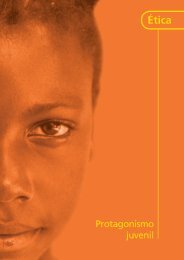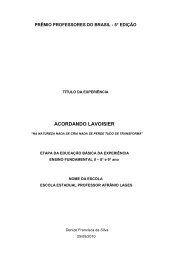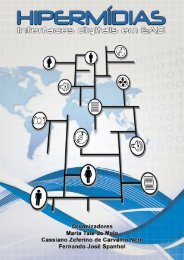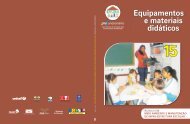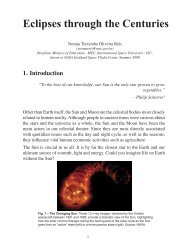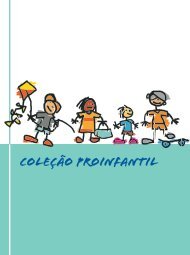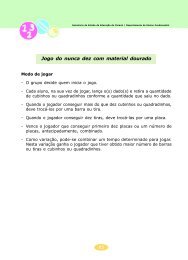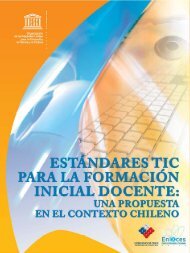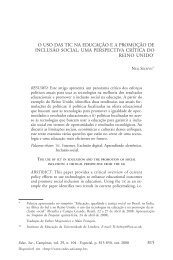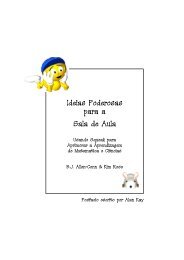BIO-CULTURAL COMMUNITY PROTOCOLS - Portal do Professor
BIO-CULTURAL COMMUNITY PROTOCOLS - Portal do Professor
BIO-CULTURAL COMMUNITY PROTOCOLS - Portal do Professor
Create successful ePaper yourself
Turn your PDF publications into a flip-book with our unique Google optimized e-Paper software.
PART I / CHAPTER 2<br />
Overall, BCPs are a statement by ILCs of their intentions to selfdetermine<br />
their futures and explain to specific stakeholders<br />
how they either wish to engage them or be engaged.<br />
BCPs present an opportunity for communities to set out their<br />
customary laws relating to FPIC regarding access to their TK<br />
and/or GR and how they want to use new opportunities such<br />
as the establishment of a protected area, a REDD project, or<br />
a payments for ecosystem services scheme. 2<br />
In <strong>do</strong>ing so, ILCs<br />
provide clarity to other stakeholders, better enabling<br />
researchers of government agencies, for example, to work<br />
with them towards the community’s proposals. Thus, BCPs<br />
provide communities an opportunity to focus on their<br />
development aspirations vis-à-vis legal frameworks such as<br />
ABS and to articulate for themselves and for others the<br />
processes that require support to protect their bio-cultural<br />
heritage, and therefore on what basis they will engage with<br />
potential users of their TK.<br />
For example, Samburu livestock keepers from Kenya said the<br />
following about the reasons for developing a BCP:<br />
We are the Samburu, pastoralists living across a number of<br />
districts in Kenya. We are keepers of indigenous and exotic<br />
breeds of livestock and our lives are interlinked with and wholly<br />
3. Community Experiences with BCPs<br />
3.1 Self-determination and Governance<br />
New legal and policy frameworks are providing communities<br />
with new opportunities to use the law to protect their ways<br />
of life, but at the same time are posing corresponding<br />
challenges. The IRABS’ focus on TK raises questions about its<br />
applicability to the way communities are defined and organized<br />
locally. A certain type of TK can be known by a subset of a<br />
community (traditional healers, for example), may be widely<br />
shared between communities or might be used across national<br />
borders. To respond to any issues relating to TK, the “community”<br />
of TK holders must first define themselves and consider who<br />
should make decisions relating to their bio-cultural heritage<br />
and overall governance.<br />
<strong>BIO</strong>-<strong>CULTURAL</strong> <strong>COMMUNITY</strong> <strong>PROTOCOLS</strong> AS A<br />
<strong>COMMUNITY</strong>-BASED RESPONSE TO THE CBD<br />
dependent on our animals. Our way of life also allows us to<br />
live alongside wildlife, promoting the conservation of our<br />
breeds and other living resources in our environment. Yet we<br />
feel that our way of life and our indigenous breeds have been<br />
consistently undervalued. The government-promoted breeding<br />
programs that sought to replace or improve our breeds have<br />
left us particularly vulnerable to the recurring droughts which<br />
are causing our people acute suffering.<br />
This is our community protocol. It is an articulation of the<br />
integral role of our breeds in Samburu culture and their<br />
importance to the world. It seeks to establish the significance<br />
of our way of life and the value of our indigenous breeds, and<br />
that as the keepers of important livestock populations, we<br />
have a right to maintain our way of life. It clarifies for others<br />
on what terms we will permit activities to be undertaken on<br />
our land or regarding our indigenous breeds and<br />
traditional knowledge. 3<br />
The next section below illustrates the types of issues<br />
highlighted by the communities as being important to their<br />
ways of life and also provides an overview of the way in which<br />
they have set out their values, concerns, challenges, and legal<br />
rights in BCPs.<br />
The issue of applicability to the local context had the most<br />
impact on the traditional healers from Bushbuckridge in the<br />
Kruger to Canyons Biosphere Region. At first, the organization<br />
was introduced to a group of 6 people who run the<br />
Vukuzenzele Medicinal Plants Nursery to discuss their rights<br />
under the South African Bio-prospecting and ABS Regulations<br />
of 2008. It soon became evident that there were many more<br />
healers in the region who knew of each other but had never<br />
met formally to discuss mutual concerns. As a result, a larger<br />
group representing two different languages was invited to<br />
the next meeting to discuss their ideas. At that and subsequent<br />
meetings, they realized that they faced many of the same<br />
challenges, including a lack of access to medicinal plants because<br />
of over-harvesting by commercial harvesters, a lack of<br />
2. Payments for ecosystem services are discussed in Chapter 6.<br />
3. Samburu Bio-cultural Protocol (working draft). For more information contact Jacob Wanyama and Evelyn Mathias, LIFE Network (Africa) at evelyn@mamud.com<br />
22




